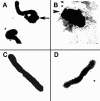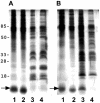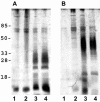The action of bismuth against Helicobacter pylori mimics but is not caused by intracellular iron deprivation
- PMID: 15155188
- PMCID: PMC415606
- DOI: 10.1128/AAC.48.6.1983-1988.2004
The action of bismuth against Helicobacter pylori mimics but is not caused by intracellular iron deprivation
Abstract
Helicobacter pylori is highly susceptible to bismuth, a heavy metal with antimicrobial activity linked to its effect on bacterial iron uptake. Three strains of H. pylori were analyzed for indicators of iron limitation following exposure to the MIC of colloidal bismuth subcitrate (MIC(CBS)). Similar morphologic and outer membrane changes were observed following growth in iron-limiting medium and at the MIC(CBS) that inhibited the growth of all three strains. These changes, which were also observed for iron-limited bacteria, were alleviated by the addition of iron to the cultures. H. pylori ATP levels, reduced in iron-limiting medium, were below the limits of detection in two of the three strains following exposure to bismuth. The addition of iron partially restored bacterial ATP levels in these two strains, although not to normal concentrations. In contrast, exposure of the same strains to the MIC(CBS) failed to deplete intracellular levels of iron, which were significantly reduced by culturing in iron-limiting medium. Thus, the antimicrobial effect of bismuth and of iron limitation on H. pylori may be similar. However, the respective mechanisms of intracellular action would appear to be mediated by different pathways within the cell.
Figures






Similar articles
-
[In vitro antimicrobial susceptibility of Helicobacter pylori strains: isolation of strains resistant to clarithromycin].Rev Med Chil. 2001 Jun;129(6):643-6. Rev Med Chil. 2001. PMID: 11510204 Spanish.
-
Activity of amoxicillin, metronidazole, bismuth salicylate and six aminoglycosides against Helicobacter pylori.J Chemother. 1996 Feb;8(1):52-4. doi: 10.1179/joc.1996.8.1.52. J Chemother. 1996. PMID: 8835109
-
Colloidal bismuth subcitrate impedes proton entry into Helicobacter pylori and increases the efficacy of growth-dependent antibiotics.Aliment Pharmacol Ther. 2015 Oct;42(7):922-33. doi: 10.1111/apt.13346. Epub 2015 Aug 4. Aliment Pharmacol Ther. 2015. PMID: 26238858 Free PMC article.
-
Role of iron in Helicobacter pylori: its influence in outer membrane protein expression and in pathogenicity.Eur J Gastroenterol Hepatol. 2000 Dec;12(12):1263-5. doi: 10.1097/00042737-200012120-00001. Eur J Gastroenterol Hepatol. 2000. PMID: 11192313 Review.
-
The actions of bismuth in the treatment of Helicobacter pylori infections: an update.Metallomics. 2012 Mar;4(3):239-43. doi: 10.1039/c2mt00180b. Epub 2012 Feb 23. Metallomics. 2012. PMID: 22358069 Review.
Cited by
-
Inhibitory Effect of Bismuth Oxide Nanoparticles Produced by Bacillus licheniformis on Methicillin-Resistant Staphylococcus aureus Strains (MRSA).Iran J Biotechnol. 2018 Dec 12;16(4):e2102. doi: 10.21859/ijb.2102. eCollection 2018 Dec. Iran J Biotechnol. 2018. PMID: 31457035 Free PMC article.
-
Helicobacter pylori Biofilm Formation and Its Potential Role in Pathogenesis.Microbiol Mol Biol Rev. 2018 May 9;82(2):e00001-18. doi: 10.1128/MMBR.00001-18. Print 2018 Jun. Microbiol Mol Biol Rev. 2018. PMID: 29743338 Free PMC article. Review.
-
Effects of bismuth subsalicylate and encapsulated calcium-ammonium nitrate on enteric methane production, nutrient digestibility, and liver mineral concentration of beef cattle.J Anim Sci. 2020 Aug 1;98(8):skaa234. doi: 10.1093/jas/skaa234. J Anim Sci. 2020. PMID: 32750137 Free PMC article.
-
Antimicrobial susceptibility testing of Helicobacter pylori determined by microdilution method using a new medium.Curr Microbiol. 2009 Jun;58(6):559-63. doi: 10.1007/s00284-009-9368-0. Epub 2009 Feb 7. Curr Microbiol. 2009. PMID: 19198938
-
Effects of bismuth subsalicylate and encapsulated calcium ammonium nitrate on ruminal fermentation of beef cattle.J Anim Sci. 2020 Aug 1;98(8):skaa199. doi: 10.1093/jas/skaa199. J Anim Sci. 2020. PMID: 32638002 Free PMC article.
References
-
- al-Aoukaty, A., V. D. Appanna, and H. Falter. 1992. Gallium toxicity and adaptation in Pseudomonas fluorescens. FEMS Microbiol. Lett. 71:265-272. - PubMed
-
- Alarcon, T., D. Domingo, and M. Lopez-Brea. 1999. Antibiotic resistance problems with Helicobacter pylori. Int. J. Antimicrob. Agents 12:19-26. - PubMed
-
- Andersen, L. P., H. Colding, and J. E. Kristiansen. 2000. Potentiation of the action of metronidazole on Helicobacter pylori by omeprazole and bismuth subcitrate. Int. J. Antimicrob. Agents 14:231-234. - PubMed
-
- Armstrong, J. A., S. H. Wee, C. S. Goodwin, and D. H. Wilson. 1987. Response of Campylobacter pyloridis to antibiotics, bismuth and an acid-reducing agent in vitro—an ultrastructural study. J. Med. Microbiol. 24:343-350. - PubMed
-
- Atherton, J. C., P. Cao, R. M. Peek, Jr., M. K. Tummuru, M. J. Blaser, and T. L. Cover. 1995. Mosaicism in vacuolating cytotoxin alleles of Helicobacter pylori. Association of specific vacA types with cytotoxin production and peptic ulceration. J. Biol. Chem. 270:17771-17777. - PubMed
Publication types
MeSH terms
Substances
LinkOut - more resources
Full Text Sources
Other Literature Sources
Medical

